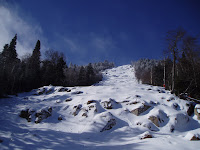Ask any skier or winter sports enthusiast, and the general consensus is that the winter of 2011-12 was one of the worst in memory. Not only was natural snowfall sparse, a lack of cold temperatures hampered snowmaking operations all season long. The result was a slow start to the ski season, a record early end, and frustrating thaws in between.
Here's how the winter of 2011-12 measures up in terms of cold, or lack thereof. Heating degree-days, as tracked by NYSERDA, represent the number of degrees by which the daily average temperature falls below 65° F. More heating degree days corresponds to colder winter weather:
The table above is for the Glens Falls NY region, but the pattern was repeated across the entire northeast and mid-Atlantic region: a significant and consistent lack of cold temperatures all winter long. In fact, we didn't even come close to "average" cold temperatures for a single month all winter. The pain is magnified when compared to last year, when consistent cold translated into a solid ski season.
Not only were temperatures mild, natural snowfall was scant as well. Snowfall at Gore was just over half of the long-term average (80" versus 150" average snowfall) and Whiteface did little better (129" versus 200" average snowfall). The pattern was repeated across New England, with Sugarbush VT, for example, receiving just 60% of their long-term average (161" versus 289" average)
Personally I had many good, if not excellent, ski days this winter, thanks to hard work by snowmaking and grooming crews at Gore, Whiteface and elsewhere. But overall, the winter of 2011-12 will likely become the benchmark by which other poor ski seasons are measured. It will be interesting to see the revenue and skier-visit figures for ORDA when they are released.


No comments:
Post a Comment